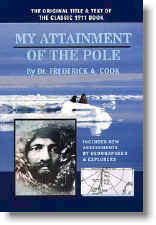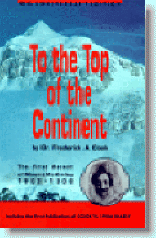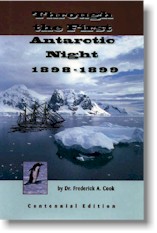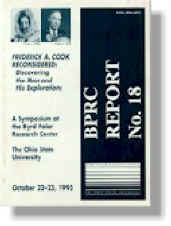|
Special
Publications
Books
Photographs
Special
publications and reprints
by the Frederick A. Cook
Society
Books
| . |
|
 |
Now
Available: A
Special 90th
Anniversary Edition!
My
Attainment of the
Pole
Being
the Record of the
Expedition that
First Reached the
Boreal Center 1907 -
1909
by
Dr. Frederick A.
Cook
|
.
Includes
the original text
by Dr. Frederick
A. Cook, plus
- special
afterwards by
Polar
historians V.S.
Koryakin and
Sheldon S.R.
Cook
- a
field
reconstruction
of Cook's
journey by Ted
Heckathorn
- a
new
bibliography
and expanded
index.
- a
32-page photo
section
includes new
maps &
charts.
- Verdict
of History:
a compilation
of explorers,
historians,
geographers,
authors and
researchers on
Cook from 1909
to 2000.
Here's
what the experts
are saying...
Jean
Malaurie, author
of "The Last
Kings of
Thule,"
explorer and
director of the
Centre de'Etrade
Arctique
"Cook
must be
considered an
extraordinary
personality in
Polar
history...he was
a Bonaparte on
the ice to his
rival..."
Raimund
Goerler, Archivist
of the Byrd Polar
Research Center
and author of
"To the
Pole."
"This
book--in which
Cook explained
his
accomplishment--
will no doubt
rekindle the
embers of the
90-year-old
Cook-Peary
controversy."
Learn
more about the
release of this
special edition!
|
.
|
 |
To
the Top of the
Continent
The
first ascent of
Mount McKinley 1903
- 1906
by
Dr. Frederick A.
Cook
Softbound
368 pages, published
in 1996
ISBN: 0-9653995-1-6
$19.95
Available
for Purchase from
Amazon.com |
The
introduction to this
Anniversary Edition of To
the Top of the Continent
calls it a "classic
mountaineering book"
by an author who may be
the most controversial
figure in the history of
modern exploration,
Frederick Albert Cook,
M.D. (1865-1940).
In
1903 Dr. Cook was the
first to circumnavigate
the highest peak in North
America, Mount McKinley, a
feat which was not
repeated for 75
years. He
explored and named the
largest glacier on the
continent after his
youngest daughter, Ruth.
In 1906 he led a second
expedition to McKinley and
announced that he and
Edward Barrill had
ascended the east ridge
and reached the summit in
September.
Three
years later Cook returned
from the Arctic and
announced that he had
reached the North Pole in
April of 1908.
Cook's claim to the
McKinley climb had not
been challenged until the
great North Pole
Controversy, and are thus
entwined in the annals of
bitter contention in the
history of exploration and
discovery.
This
90th Anniversary Edition
includes an interpretive
analysis of Cook's
expeditions by the leader
of the 1994 party which
followed his route.
It also contains a
transcription of the Cook
and Barrill 1906 diaries
with a historical account.
 |
Through
the First Antarctic
Night 1898-1899
A
narrative of the
voyage of the "Belgica"
among newly
discovered
lands and over an
unknown sea about
the South Pole
by
Dr. Frederick A.
Cook
Softbound
520 pages,
published in
1998
ISBN:
0-9665613-1-7
$19.95 |
.................. |
Hardbound
520 pages,
published in
1998
ISBN:
0-9665613-0-9
$49.95 |
Available
for Purchase from
Amazon.com |
In
the closing years of the
nineteenth century, a
little-known expedition
sailed from Belgium with
the first truly
multi-national group of
officers, scientists and
crew. The "Belgica"
was to spend an unintended
Polar night deep below the
Antarctic Circle.
Locked in the ice of the
Bellingshausen Sea for
over a year, the ship
would become a virtual
laboratory of human
endurance for its
19-member crew. The
dramatic emergence of two
explorers on this
expedition would lead both
to internationally
acclaimed expeditions a
few years later--Frederick
A. Cook as the first to
claim discovery of the
North Pole in 1908, and
Roald Amundsen as
discoverer of the South
Pole in 1911.
In
the Centennial Edition of
this classic book of the
expedition, the story is
brought to a wider
audience.
Exceptional
photography--pioneered by
Cook who served as
expedition
surgeon--provided an
insight into this
experience,and this
edition combines these
original Antarctic images
with contemporary color
photographs of the same
regions explored by the
"Belgica."
Two highly-regarded polar
historians--Prof. Susan
Barr of Norway and Prof.
T.H. Baughman of the
U.S.A.--have new
contributions to give this
historic event its
rightful place in our
modern era of
understanding the
Antarctic.
The
Photographs of Dr. Cook:
From Albums in the Attic to
Digital CD
The
Frederick A. Cook society
has made available its
extensive collection of
polar photographs through
the Byrd Polar Research
Center at the Ohio State
Universtiy. To
inquire about the
collection and to purchase
photo reproductions,
contact Laura Kissel, the
Polar Curator, at
614-688-8173 or by e-mail
at kissel.4@osu.edu.
>
Learn
more about the collection
and see more sample
photos.
Special
publications and reprints
by the Frederick A. Cook
Society
The
Frederick A. Cook Society
publishes the proceedings
of their conferences:
 |
Frederick
A. Cook
Reconsidered:
Discovering the Man
and His Explorations
A
Symposium at the
Byrd Polar Research
Center
The
Ohio State
University
October
22-23, 1993
135
pages, softbound,
published in 1996,
ISSN: 0896-2472
Available through
the Cook Society for
$13.25 for
non-members, $8.25
member price.
Shipped via priority
mail. |
In
October, 1993 an
international symposium
with polar researchers,
scholars and field
explorers gathered at the
Byrd Polar Research Center
on the campus of The Ohio
State University to
discuss the life and work
of the man who may be this
century's most
controversial explorer:
Frederick Albert Cook
(1865-1940).
Ten
professional papers were
presented at the two-day
gathering held in the sir
Hubert George Wilkins
Lecture Hall of the Byrd
Center. Such
prominent field explorers
and research scientists as
Wally Herbert, Jean
Malaurie, Joseph O.
Fletcher and Brian
Shoemaker were among
scholars from five
nations, representing
various disciplines.
A
unique perspective of the
North American Inuit, or
Polar Eskimo, was offered
through presentations from
a Danish anthropologist
and also a historian and
writer of the Inuit.
They gave that view of the
key Inuit participants in
the Cook expeditions and
that of his rival, Edwin
Peary (1856-1920).
New
postulations on the
disputed Arctic Ocean
journey of Cook to the
North Pole in early 1908
were offered, including
data on the Arctic Ocean
currents assembled in
recent decades, and
related to Cook's original
observations.
The first commander of the
famed "ice
island" laboratories
and the Navy captain who
closed that research
presented their work in a
historical perspective for
the first time at a
gathering of Arctic
experts.
Dissenting
views were made, including
Herbert, leader of the
first Trans-Arctic
crossing in 1968 and the
world's leading classic
dog sled explorer. The ten
presentations and a
concluding exchange among
the symposium participants
form the Anthology, which
will include standard
reference citations and
bibliographies. This
volume has extensive
photographs, maps, charts
and tables.
 |
Reports
of the Conference on
Polar
and Alpine Medicine
The
Proceedings of the
first symposium of
Polar and Alpine
Medicine include
papers on scurvy,
high altitude
medicine,
SAD, cold injuries
and much more.
Presented
at The Explorer's
Club, New York City
September
25, 1999
54
pages, softbound,
published in 2000,
ISSN: 1086-4881
Available through
the Cook Society for
$13.25 for
non-members, $8.25
member price.
Shipped via priority
mail. |
Since
the earliest times,
exploration has been
driven by a desire to
learn what is beyond one's
horizon and to experience
the thrill of the search
for the unknown.
However, all too often
these lofty idealistic
motives are dominated by
more realistic motives
driven by the economics of
the times, wars, religious
fervor, desires for
nationalistic expansion
and pride, as well as an
individual's own drive for
fame and fortune.
As
geographical and
technological knowledge
expanded through the ages,
the scope of exploratory
efforts expanded to an
enormous degree, reaching
into previously unexplored
areas. During the
Middle Ages, two important
historical events
significantly contributed
to this development,
resulting in the discovery
of new lands, people,
environment and diseases.
One event was the
Crusades; the other was
the fall of the Byzantine
Empire and the capture of
Constantinople by the
Ottoman Empire. Both
of these events were
responsible for uncovering
scurvy, one of the major
scourges that plagued
exploration for the next
four centuries.
Physicians
have played a prominent
role in explorations,
especially in the 19th
century surge of interest
in Arctic
exploration.
Interestingly, despite the
hardships encountered
including loss of life,
there always seemed to be
a ready supply of
available and worthy
physicians interested in
exploration. History
is replete with the names
of physicians who
distinguished themselves
by their services.
Elisha Kent Kane, Isaac
Israel Hayes, Frederick A.
Cook, John Richardson and
John Rae are among those
who made significant
contributions to the art
and science of polar
medicine. Drs. John
Ambler, Octave Pierre Pavy
and Edward Wilson lost
their lives on Polar
expeditions.
During
the 20th century, the
Antarctic became the scene
of extensive exploration
culminating in the
attainment of the South
Pole by Amundsen and
Scott. At this time
attention was also
directed to mountaineering
with the resultant
successful attainment of
the summits of Mt. Everest
and the other Himalayan
peaks as well as Mt.
McKinley (Denali) in
Alaska. This focused
attention on the medical
problems associated with
high altitude
mountaineering with a
resultant return of
valuable physiologic and
pathophysiologic knowledge
that aided in our
understanding and
successful treatment of
the high altitude medical
syndromes.
The
current proceedings are a
record of a series of
presentations on Polar and
Alpine Medicine made on
September 25, 1999 at the
Explorer's Club in New
York City. They
cover an array of topics
concerning specialized
medical problems
encountered under these
special circumstances and
are presented by a group
of physicians who have had
unique hands-on,
first-hand experience with
them.
Copyright
2005 - The Frederick A.
Cook Society
|